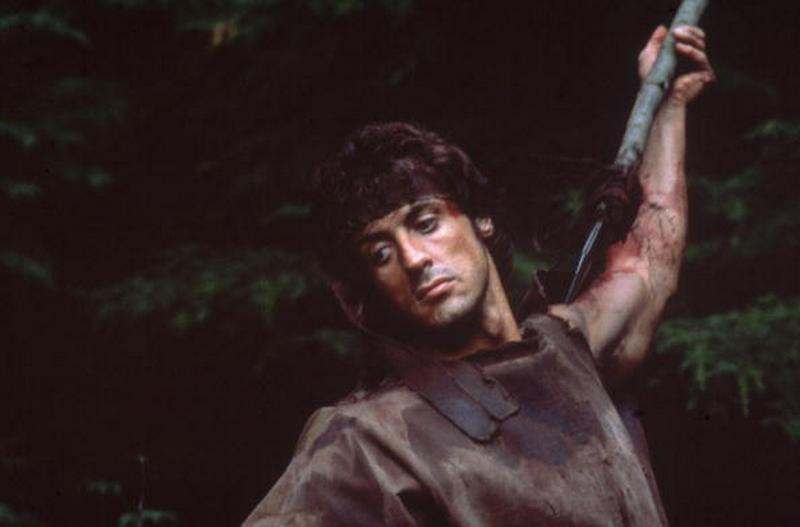How Sylvester Stallone's "First Blood" Almost Failed
By | August 7, 2022

In 1982’s “First Blood,” Sylvester Stallone inconceivably ingrained yet another iconic character into pop culture consciousness with Rambo. Harrison Ford remains the only actor who can boast two equally pantheon-worthy characters. Everyone else’s twosome pales in comparison to Rambo and Rocky. Ironically, Stallone and about half of Hollywood passed on “First Blood” while it meandered through the convoluted machinations of movie-making.
It took infamous ‘80s action producers Mario Kassar and Andrew G. Vajna to get this classic off the ground. Even after filming, Stallone felt the movie might sink his career, so he attempted to buy and bury it. Thankfully, some critical edits helped spawn one of the great action franchises of all time. Here's how “First Blood” paved the way for five Rambo flicks.

The Creative Crawl
Author David Morrell wrote the 1972 novel “Rambo,” inspired by the real-life actions of highly decorated WWII soldier Audie Murphy. Columbia Pictures optioned the rights before they began the age-old Hollywood shuffle onto Warner Bros., eventually falling into the crowded wormhole where ideas go to die.
During that 10-year odyssey, a host of Tinsel Town’s finest was “loosely attached.” That prestigious list included Al Pacino, Robert De Niro, Steve McQueen, Paul Newman, John Travolta, Clint Eastwood, Nick Nolte, and Dustin Hoffman. The film’s struggle through that studio system was precisely why Stallone initially turned down Kassar and Vajna when they approached him following the rampant success of “Rocky.” Eventually, the producers persuaded him to accept with a $3.5 million payday and some script changes.
Fork In The Road
Originally, Kirk Douglas was cast for the role of Colonel Trautman but left early in production over a major plot point. In the novel, Rambo dies at the end and Douglas felt the movie should remain faithful to that ending.
Stallone and director Ted Kotcheff, not to mention eventual test audiences, all strongly disagreed with the matinee idol. Apparently, the disagreement became so contentious that Douglas delivered an ultimatum: Rambo dies or he’s out. Therefore, at a moment’s notice Richard Crenna played Rambo’s mentor.

The Most Iconic Knife In Film History
For Rambo’s weapon of choice Stallone, a knife aficionado, tapped famed knife maker and friend Jimmy Lile. The actor felt the knife represented an extension of Rambo, hoping “almost to make the knife into a character itself.” As Liles reported in ‘85, “He told me he wanted something different, something that everyone else didn't have. And that is what I made for him."
John Hill, knife collector and friend of Liles believes, “You can flash the silhouette of that knife anywhere in the world today and they’ll say, ‘That’s the knife of John Rambo!’”
According to The Washington Post sales of survival knives, similar to Rambo’s, went through the roof following the first two films. Also, Blade Magazine stated that Rambo’s famous weapon did "for the cutlery industry what 'Dirty Harry' did for the .44 Magnum pistol. Every man and his brother has to own one just like the one in the movie." The retail value of the 100 blades that Lile made for the film range from $15,000 to over $75,000. Rumor has it that Stallone kept knives 1-6 and each could fetch well over those estimated prices!
Real Blood
Stallone clearly went the extra mile in the name of authenticity and evidently, the entire production followed his lead. In the scene when Rambo escapes from jail by dispatching “Lester” played by Alf Humphreys with a well-placed elbow, Sly actually broke the Canadian actor's nose! The stuntman playing Sheriff Teasle really pushed the envelope by launching the car on an assisted ramp while approaching the railway crossing. The ensuing crash to earth left him temporarily unable to walk.
Despite all those harrowing stunts, the final product remained bogged down to the point that Stallone worked to mothball the film altogether. When the powers-that-be declined, he talked them into extensive edits that helped the film move and create the template for the modern action movie. The crazy process that gave us a hall of fame action film proves a lot of success comes down to luck.
